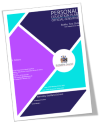
When you are setting targets for your PEP, there are several areas you need to consider, the information below should guide your decisions on setting targets and questions to ask before recording them.
Focus on the child/young person - keep them in mind | What is their current attainment in English and Maths based on last terms data? What are their end of Key Stage and GCSE/A Level/BTEC targets? Specific gaps in learning stopping them achieving the comparable results as their peers? What do they need to know in order to address the gaps? Must be measurable. What additional help do they need to accelerate learning? How can this be provided in school and beyond? You may need to focus on another academic subject too alongside English |
What are the barriers to learning? | Is punctuality or attendance an issue? Does challenging behaviour prevent learning? Behaviour should be challenged but it is necessary to have a bespoke approach based on a child's needs and circumstances. Does attention wander? Are relationship issues affecting learning? What are the child's wider needs? What can be done to address these barriers within school and beyond? |
How will you break down the barriers? | Current provision: could planning, seating, curriculum or teaching be adapted? Is quality intervention necessary? What form would this take? Are there SEN resources which could be used? Could 1:1 support be put in place? Is external support required? Joined up support? Would extra tuition help? What other resources would help? IT, books etc? |
What are the cost implications? | Are specific material resources required? If needed, cost out the hourly cost of extra support using this formula: 'Number of hours a week x hourly rate of staff member x number of weeks in the term.' Cost of any external support will be specified by the provider. In the best cases, additional tuition run by teachers after school and can be funded through the child's PP+ and careful use of NTP. If in any doubt, please contact the Virtual School. |
How will success be measured? | What will success look like to the young person? Has there been pre and post assessment, particularly of intervention/tutoring? Show where the child is now and where you want them to be to achieve. Test results can be a measure of success and can show continued increase in % Increase in reading/spelling age. (Increase in months shows clear progress) Use rewards earned for good behaviour/choices as a measure - Number of positive/negative points on their record compared to what the child had initially Increased attendance % or improved punctuality (where a reduction of lates can clearly be shown or an increase in overall % shows the pastoral target has been met) Do they now know more than they did before? (Improved scores in specific topics) SDQ scores can relate to emotional wellbeing etc. / have they increased their participation in wider school activities?
|
Pupil Premium Plus (stat aged only) | Don't focus on the finances rather than the child. Think about what the child needs to make progress, to achieve the targets set. PP+ funding for children we look after is managed by the VS and not passed directly into school. The funding must be used for the educational benefit of the child as described in the PEP and can only be accessed and allocated through a clear and focused PEP. Please refer to examples sent out previously. If you feel the child needs more support, please get in touch to apply for additional funds through the request form. |




